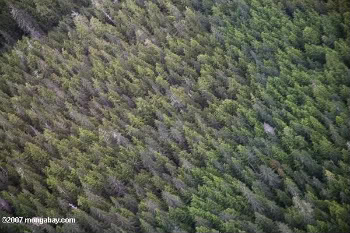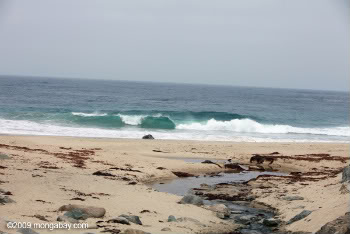Sobering report is the most comprehensive to date.
Government officials and scientists released a 196 page report detailing the impact of global warming on the U.S. yesterday. The study, commissioned in 2007 during the Bush Administration, found that every region of the U.S. faces large-scale consequences due to climate change, including higher temperatures, increased droughts, heavier rainfall, more severe weather, water shortages, rising sea levels, ecosystem stresses, loss of biodiversity, and economic impacts.
Entitled ‘Global Climate Change Impact in the United States’, the report was crafted by 13 governmental science agencies, several top universities, and research institutions.
Speaking yesterday, President Obama’s chief science advisor, John Holdren, described the report as “the most up-to-date, comprehensive and authoritative assessment” of the affects of climate change on the U.S. He said that the report looks at climate change impact regionally, because that is “where people actually experience it: in their back yards.”
The report splits the U.S. into nine regions: Southwest, Northwest, Great Plains, Midwest, Southeast, Northeast, Alaska, islands, and coastal regions.
Southwest
 Golf course outside of Las Vegas: the Southwest’s water shortages will only worsen according to report. Photo by: Rhett A. Butler. |
In the Southwest, the report finds that water-scarcity will be paramount in the coming decades, describing the possibility of ‘conflict’ over competing interests for dwindling water sources, due to reductions in spring precipitation and a growing population.
The report also found evidence for increased droughts, wildfires, and invasive species. Droughts and warmer temperatures are likely to affect agriculture across the region, while already-worsening wildfires will threaten property and forests.
Economically, the region is likely to suffer from depressed tourism, especially in the winter months when many activities, such as skiing, will be affected by depressed precipitation.
Northwest
Like the Southwest, the report finds that the Northwest will face water supply issues, due to declining springtime snowmelt.
 Redwood in Big Sur. Northwest trees are predicted to experience decreased growth due to a warmer U.S. Photo by: Rhett A. Butler. |
The rich ecosystems of the Northwest are likely to suffer from wildfires, increased insect outbreaks, and species migrating due to changing temperatures. Trees are expected to experience decreased growth due to drought and higher temperatures. Such changes will inevitably affect the forestry industry.
In addition the report predicts that salmon—already dwindled from historical populations—will suffer declines due loss of habitat from warmer temperatures.
Finally, a rise in seas-levels is expected to increase erosion along the coasts, swallowing beaches and threatening areas in the south Puget Sounds.
Great Plains
The Great Plains region also faces water shortages, due to increased droughts, higher temperatures, and faster evaporation rates.
The region, dependent largely on agriculture, is expected to suffer from increasing insect infestations, less precipitation, and shifting growing zones due to higher temperatures. Crop yields could be significantly affected.
The report also predicts trouble for the regions’ ecosystems, which have already been stressed due to changes in land-use. Native birds are likely to experience habitat shifts, while some native species may not survive ecosystem changes when already stressed by habitat loss.
Midwest
The Midwest is also known as the Great Lakes region. However, the report predicts that the Great Lakes are likely to face reduction in water levels, affecting everything from recreation to shipping.
The report finds that the region will experience more precipitation in the winter and spring, but greater evaporation in the summer. This will lead to both increased flooding and periodic water shortages.
The Midwest will have a longer growing season because of higher temperatures (the growing season has already increased by a week), but with this will also come more heat waves, insects, and weeds, in addition to the new pattern of too-much-water and not-enough.
 Bald eagle in Alaska: species throughout the U.S. will be threatened by shifting ecosystems and the need to migrate. Photo by: Rhett A. Butler. |
The report predicts that native species will shift their ranges due to higher temperatures and new pressure from southern species moving north. Unfortunately due to large cities and sprawling suburbs, as well as the Great Lakes, many species may find they have no place to go.
Southeast
Already hot, the Southeast will only become hotter, leading to a worsening of heat-related health issues. As well, forest growth, agricultural yields, and livestock production are expected to decline due to the hotter temperature. Water shortages, already occurring (most notably in Atlanta in 2007), will grow more frequent.
The study also found that the region will face increases in hurricane intensity and flooding from more intense storm surges. Low-lying communities are most threatened; portions of the coast could be inundated for good.
In a region dependent in part on tourism and retirees attracted to the ‘sunbelt’, it is expected that the combination of worsening heat, water shortages, and severe weather will make the region far less attractive, thereby depressing the economy.
Northeast
A region known for its massive cities is likely to experience more heat waves, worsened by the urban heat affect. The study predicted major cities will experience an average of 20-30 days above 100 Fahrenheit every summer, whereas now most of these cities experience just a few days that rise above that marker.
Agricultural production will be forced to change; some well-known crops like apples, blueberries, cranberries, and syrup are likely to become more difficult, if not impossible, to grow. In addition, both lobster and cod fisheries are likely to be adversely affected by the species shifting their ranges.
Coastal flooding due to sea-level rise is expected to occur across the region, threatening some urban areas.
Winter sports, important for the tourism industry, could see their season cut in half.
Alaska
On the front-lines of climate change, Alaska has warmed more than twice as much as any other region in the U.S.
While Alaska could benefit from a longer growing season, decreased soil moisture may negate any potential benefits. As well Alaska’s white spruce forests are experiencing decline in growth and widespread mortality due to longer summers.
 Temperate rainforest in Tongass National Park: Alaska’s iconic wilderness faces more fires and insect infestation. Photo by: Rhett A. Butler. |
A warmer Alaska also means worsening insect outbreaks, since winter is no longer cold enough to kill-off species like the spruce beetle. In addition, worsening wildfires are expected.
The thawing permafrost is causing land to sink, damaging homes and public infrastructure, costing the state billions of dollars for repair costs. In addition, the thawing permafrost endangers coast lines already threatened by loss of sea ice and rising sea levels.
While polar bears have become the poster-child for global warming, a number of Alaskan species, both marine and terrestrial, could experience shifts in ranges and other stresses due to the large-scale changes in their ecosystems.
Islands
Most pressing for the state of Hawaii and other island territories is the loss of coasts due to worsening storm surges and rising seas levels. The report predicts frequent flooding and the permanent loss of some coastal lands.
Freshwater, already a difficult-to-come-by commodity for islands, is likely to become even scarcer, since rising sea levels will inundate some freshwater sources with seawater.
Fisheries are expected to see significant declines, since coral reefs are being lost to bleaching caused by warmer temperatures, while ocean acidification is causing the spread of ‘dead zones’. Shifting ranges for fish will also impact the industry.
U.S. coastal regions
 Beaches like this one in Big Sur California may disappear after a predicted sea-rise of 3 to 4 feet. Photo by: Rhett A. Butler. |
Goodbye, to some coastlines: the report highlights that worsening storm surges and rising sea levels will lead to the loss of some coast lands, pointing to the 1,900 square miles of coastal wetlands in Louisiana that have become sea in the last century. In all the report predicts a sea level rise of 3 to 4 feet in the next century.
‘Dead zones’ created by fertilizer and sewage runoff are likely to worsen with warming. In addition, marine life is likely to move northward because of warming waters.
Coral reefs face multiple stressors, including higher temperatures and ocean acidification. The study predicts that this double whammy will cause coral reef loss throughout U.S. coastal waters.
Conclusion: Finding Hope
“This is the most thorough and up-to-date review ever assembled of climate-change impacts observed to date as well as those anticipated in the future across the United States,” says Evan Mills, a scientist at Berkeley who contributed to the report. “The good news is that the harshest impacts of future climate change can be avoided if the nation takes deliberate action soon. This can be done through a balanced mix of activities to reduce greenhouse-gas emissions and adaptation to the otherwise unavoidable impacts.”
 Along with rising sea levels, islands like Maui also face freshwater shortages. Photo by: Rhett A. Butler. |
Environmental groups pointed to the report as evidence that the U.S. needs a strong climate bill now.
“This is the clearest of wake up calls—climate change is here and the time for action is now,” said World Wildlife Fund US CEO Carter Roberts. “As Congress debates landmark legislation to solve our energy and climate crisis, this report provides conclusive evidence that our planet is already changing before our very eyes, with enormous implications for our nation’s economic future and way of life. Already Americans are paying the price for the lack of action on climate change in the past and those costs will only rise. It’s time for Congress to act. ”
Jane Lubchenco, head of the National Oceanic and Atmospheric Administration, a lead agency on the report, said that “climate change is happening now.” But while the findings in the report are cause for concern, she emphasized that it’s not too late to change the predictions.
“Trends are not destiny,” she said.
Related articles
US responsible for 29 percent of greenhouse gas emissions over past 150 years
(05/31/2009) In the past 150 years, the United States has emitted more greenhouse gas emissions than any other nation in the world, according to a recent report by Greenpeace. In fact, US emissions account for 29 percent of the world’s total since the mid-1800s. The US emitted 328,264 million metric tons of carbon dioxide (MtCO2) in the past 150 years, which is over 3 times the amount emitted by China in the same century-and-a-half.
Global warming estimates double in severity according to new MIT modeling
(05/20/2009) Employing the MIT Integrated Global System Model, scientists have found that global warming could be more than twice as severe as previous estimates six years ago. The MIT Integrated Global Systems Model, which uses computer simulations to analyze the relationship between climatic changes and the global economy, found during 400 runs of the model that there is a 90 percent probability that temperatures will have risen 3.5 to 7.4 degrees Celsius by the end of the century.
Colorado River unlikely to meet current water demands in warmer, drier world
(04/20/2009) Feeding the water habits of such major cities as Los Angeles, Las Vegas, and Phoenix, in addition to providing irrigation waters for the entire Southwestern United States, has stretched the Colorado River thin. The river no longer consistently reaches the sea as it once did. Now a new study warns that the Colorado River system, which has proven dependable for human use throughout the 20th Century, may soon experience shortages due to global warming.













